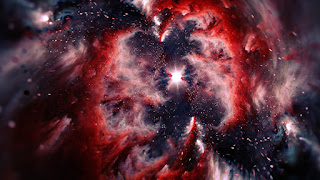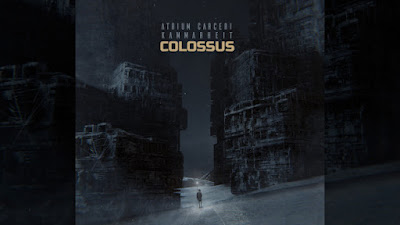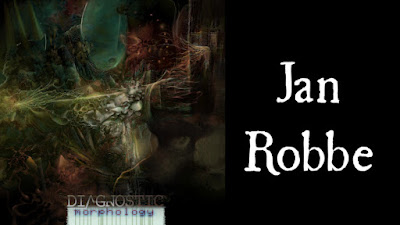Dark Ambient Interview:
Jan Robbe
Jan Robbe is a
composer, programmer, artist and sound designer, one with a love of
broken rhythms, experimental electronic soundscapes, and the
possibilities afforded by using technology in the creative process.
Along with co-founding the netlabel Entity, Jan has various music
projects to his name including UndaCova, Atomhead, Duncan Avoid and
Diagnostic, the last of which is how we began chatting.
In this interview, Jan
reveals how he got started with the tracker scene back in the 90s,
the perils of getting stuck in one type of creative style, and who
his inspirations are. He also tells us which software and hardware he
likes to utilise, how he uses neural networks as an aid to his
creations, and why he thinks that humans using A.I for creativity is
a dance that benefits us greatly.
* * *
Casey: The
description of the latest album under your Diagnostic name,
Morphology, tells the listener that you utilised things such
as non-linear feedback loops and neural networks, among other
approaches, when you created this album. Before we get to that
though, in the 90’s, you experimented with tracker software on
hardware that was far less powerful than that which is available
today. What brought the young Jan Robbe to music creation, and what
sort of software and hardware were you using back then?
Jan:
Back then my interest in music creation coincided with the discovery
of the tracker scene. Simply searching for free music on the
internet, that was also small in download size (actually a factor at
that time) led me to the Fasttracker / Impulse Tracker software that
many artists were using. I remember being shocked by how good the
music actually was, even though netlabels were putting it online for
free, it was a true explosion of creativity.
So I used
Fasttracker at first, but my music wasn't very good. It wasn't until
Fruityloops came along, with the support of VST plugins, that things
really got interesting. I understood that I didn't actually need to
buy any sophisticated hardware to make pleasing sounds, in fact it
was all pretty much free of charge.
Around 1999 was
when I really caught the producing bug and decided I would make a
track every day, with the sole mission of making something that I
could be proud of, and perhaps also something that others would
enjoy.
Casey: Committing to creating a track every day
and doing it for the intrinsic feeling of satisfaction are both great
ways to go about any sort of creative endeavour. Have there been
periods where you fell out of love with the music or the process, for
whatever reason, and are there any other mental approaches or
techniques that you use to help to get yourself back on track?
Jan:
Especially in the very beginning there were several moments where
I simply gave up. It takes a lot of time to grasp all the concepts
(synthesis, mixing, compression, fx, ...), but my love for music has
always brought me back. By now it's my preferred creative outlet, I
almost need it to feel sane, to catch emotional unease by the throat.
Or simply for my own enjoyment.
There have been
periods where I just lacked the time or inspiration, but I keep in
mind that these are only temporary. Life gets in the way since it's
never been a sustainable thing for me. Getting stuck in a singular
style has also proven to be a problem, but changing up, learning new
styles is just endless fun. There's always some artist that will
inspire me to make something new.
Casey: Who were some
of your biggest influences and inspirations when it came to the music
that you wanted to create, and how might this have led to you
co-founding the Entity website?
Jan: I remember feeling
bothered with commercial electronic music being very repetitive and
similar. There was a clear opportunity to just break things, you
know, like broken rhythms, breakbeats, but not as a looping
structure... I wanted it to just keep on breaking itself with endless
variation. Aphex Twin seemed like one of the first to really execute
this idea properly, with Squarepusher and Autechre working in
parallel and really pushing the boundary of sound. Along came
Venetian Snares, which really spoke to me as I always preferred the
harder side of music.
But you know, life
isn't all metal and violence, so in that regard, say around 2002, I
found my counterpart in ambient and more specifically, dark ambient /
drone music, just to cover a wider emotional spectrum, using music as
therapy.
In 2003, with my
friend Nico, we started a website to promote the experimental
approach in electronic music. Something that wasn't genre-bound, but
simply sounding good to our ears with the artists' authenticity
shining through: Entity. This way we got to really know and discover
artists, work with them and help them reach some listeners, however
small the audience, it didn't matter much as we felt connected in our
cause. We all know we are an odd bunch anyway.
Fast forward to
today, the list of artists I appreciate just keeps on growing. In my
current playlist there's KK Null, SØS Gunver Ryberg, Fernanda
Martins, Alphaxone, ProtoU, Marco Monfardini, Oophoi and Ionosphere
to name a few.
Casey: As with so much in the music
world, the technological world has advanced a great deal in a few
short decades. What have been some of the most exciting tools for you
to use during that time, and what does your current
composing/creation environment include?
Jan: Along came
things like Native Instruments Reaktor, Absynth and
granular synths (most notably the native Granulizer in FLStudio
and Robert Henke's Granulator) which really took sampling to
the next level. In later Atomhead works I got a bit obsessed with Rob
Papen's Subboombass which served as the basis for a lot of my
drums / bass sequences. UHE Bazille became my go-to modular
emulator, and eventually got me into the analog modular domain.
For a couple of
years now I've collected Eurorack modules and experimented with them,
and while there is certainly a uniqueness to this approach, and
improvisation is very gratifying, I find myself returning to the
digital domain since I see myself more as a composer / programmer /
sound designer than a performer.

Casey: For Morphology,
you made use of machine learning to create the sounds it contains.
What need does machine learning fulfil in your creative process, and
how do you train the neural network to give you output that is in the
ballpark of what you are looking for... Or do you use it more as an
element of chaos and let it throw up things for you to spring off
from?
Jan: I've always had an interest in how the brain
works, how we perceive music and sound, so when the opportunity
arises to experiment I gladly jump on the train. A.I is an important
evolution, of which we are only scratching the surface. It is
evolving at an enormous pace, it's actually hard to keep up, but
using Google Colab's cloud computing service it became more
convenient as some of the notebooks are easier to grasp and don't
require an advanced degree in programming to use.
Using the Jukebox
AI notebooks, there are a couple ways to go about it. One method is
to prompt it with a piece of music, and have it "guess"
what the continuation might be, based on a large pre-trained database
of music or "model". When you are in a creative rut, it's
obvious how this output could be used to your advantage since the
results are entirely unpredictable.
For Morphology I
found it more apt to train my own neural network, based on the
material that I had already created, in order for it to produce
variations of itself. Most of the time it tends to output a mess of
unintelligible garble. But once in a while, something entirely unique
comes out of it, something that also displays actual emotive content,
that I wouldn't have created myself, though it still contains the
gist of the sources so it would "fit" with the
rest.
Casey: The other element mentioned in the
description of Morphology is chaos, by way of non-linear
feedback loops. I’d imagine that your neural network’s output
produced plenty of chaos that also made it into the track. How
important was it for you to have some chaos in Morphology, why
does it appeal to you, and why are non-linear feedback loops a fine
place to find it?
Jan: Chaos is not just a kind of
randomness, it's best understood in terms of Chaos Theory, a chapter
in System Dynamics, which covers emergent complexity.
Using modular synths,
chaotic feedback systems can be quite easily achieved. My favourite
method is to patch the output of an oscillator into a filter, then
feed it back into the oscillator (SYNC or FM inputs). Many strange
noises will ensue and it doesn't take a lot for it to go completely
haywire, going off on its own tangents (simply automate the filter
cutoff or something).
There's more
methods, for example there are modules which can create Lorenz
Attractors or similar chaotic functions. They can act like an LFO,
without exactly repeating themselves. So it's non-repetitive, much
like a non-periodic tiling (e.g. Escher or Penrose), it tends to
sound more interesting, alive, unpredictable, than something which
simply repeats itself.
Casey: Alongside your music
creation projects, you’ve long had an interest in generative
design, making use of its concepts when it comes to your fractal
computer artwork, and in your 2014 game Hyperspace Invaders.
At the moment, a key element seems to be the human involvement in
training or assessing what the software outputs, making sure that it
achieves a certain task or function. What advancements in areas such
as machine learning, would you most like to see with regards to
things that you might currently find restrictive or a struggle, and
do you have any concerns about the paths that A.I might take us down
when it comes to the creation of art in whichever form?
 |
| Hyperspace Invaders Screenshot |
Jan:
I can't wait for these systems to become faster and more
convenient. I don't see a problem for creativity, quite the contrary.
Humans will adapt to this technology, like a dance. I've heard
someone say that "the code is the art", and while I agree,
I also still think that selecting and applying the output are
creative choices. For example, text to image, where you prompt the
neural network with keywords (like "a cat in a bag travelling
into another dimension")... it generates a picture based on your
description. It could be the final form. Or it could inspire you to
make a game or movie concept or anything you can imagine. Imagination
is limitless. A.I is simply an extra tool for us to employ. An
extremely powerful one at that.
Casey: As
someone with a finger in so many creative pies, what does the
immediate future hold for your creative endeavours?
Jan: I'm
focusing on sound design and composition for video games, at least I
will try and see if that's a feasible thing to find a job in. I want
to check out more A.I. scripts, both in audio & image/video, it's
very exciting.
Perhaps at some point I
will have another stab at a mini Hyperspace Invaders iteration
(hyper casual), if the situation permits it.
I'm finishing a
flashcore EP with my friend Eelke of Anti-Narcose Records which will
probably be my next release.
I definitely want to
make more ambient-style things too, both in collab and solo. I would
love to dedicate more time to Entity. But as you can probably tell,
that's a lot for one plate, so, don't wait up, just have a check now
& then :)
* * *
Thanks so much to Jan
for taking the time to chat with me. If you’d like to read more
about Morphology, I’ll be writing and posting my impressions
in the coming days. (Casey from the future says looky here).
You can find Jan’s
creations in a variety of places, such as Bandcamp, Soundcloud and
Facebook. You’ll find his digital art (such as the picture below) at FRAMEofMIND, and the
netlabel at Entity. You an also find Hyperspace Invaders on
Steam.
 |
| Catharsis by FRAMEofMIND |





